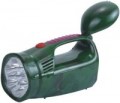Number of diodes
The number of LEDs (see "Lamp type") provided in the design of the lantern.
At first glance, the more LEDs, the more powerful this model. However, in fact, things are not so clear cut. Firstly, one high-end LED may well provide more light output than several inexpensive diodes. Secondly, modern luminaires can use both traditional LEDs and arrays of numerous miniature diodes on a common basis. Such arrays can be implemented using SMD technology or more advanced COB; the differences between these options are described in more detail in the Diode Model section, here we note that a solid SMD or COB plate is also considered to be 1 LED — despite the fact that in terms of luminosity it can exceed conventional LEDs by several times, or even orders of magnitude.
Thus, it is hardly worth directly evaluating the brightness and efficiency of the flashlight by this parameter. But what the number of diodes often directly affects is reliability: most “repeatedly charged” lamps are able to continue working even if some of the diodes fail. In addition, in some types of flashlights — in particular, tourist models and hand-held diffused lamps (see "Type") — each LED illuminates a separate sector, and together they cover a full 360 ° horizontally.
Max. operating time
Maximum runtime of the flashlight without changing batteries or recharging the battery.
Note that in models with brightness control, this time is indicated for the most modest and, accordingly, economical mode. For example, in a flashlight with a maximum luminous flux of 1000 lm, the claimed operating time of 20 hours can be achieved at a brightness of only 30 lm, and at maximum battery life may not exceed half an hour. These nuances should be clarified according to the detailed characteristics. However, also note that additional modes of operation (see below) are not taken into account in this case: for example, if the flashlight from our example in SOS mode can operate for 30 hours, the characteristics will still state 20 hours.
It is also worth bearing in mind that for models with replaceable batteries, the actual operating time will also depend on the quality of such batteries. For example, for flashlights for AA and AAA elements, battery life is most often given when using high-quality alkaline batteries; if instead of them inexpensive saline ones are used, the operating time may be several times shorter.
In general, when choosing a flashlight according to the maximum operating time, it does not always make sense to focus on “long-playing” models: they often have either low power or impressive weight / dimensions, and the price can significantly “bite”. Flashlights with a long battery life will be useful first of all to those who have to s...tay “away from civilization” for a long time: extreme tourists, rescuers, military, etc. And for most everyday tasks in a modern city, and even for trips to nature for several days, up to 10 hours is enough.
Brightness levels
The number of brightness levels provided in the flashlight design. Most modern models have one level of brightness, but there are models with the ability to adjust.
Several levels of brightness allow you to choose the best option for a particular case: for example, to view a small room, you can reduce the brightness and save battery power, while in a large warehouse you may need full power of the flashlight. Accordingly, the more brightness levels are provided in the design of the flashlight, the wider your options for choosing the best option will be.
Also note that in addition to step-by-step brightness adjustment, with fixed levels, modern flashlights can also be used with smooth adjustment. It is detailed below; here we note that the stepped format is technically simpler, cheaper, and therefore is used much more often. And in individual lamps, these options are combined — for them, the characteristics indicate both the number of individual brightness levels and the presence of smooth adjustment. The specific way to implement such a combination may be different. For example, a brightness control ring can have several fixed levels with clear values, and the ability to set any intermediate position between these values; the main mode of operation with smooth adjustment can be supplemented with a fixed level of reduced or increased brightness; etc.
Battery capacity
The capacity of the battery provided in the design or delivery of the flashlight.
Theoretically, a higher capacity allows to achieve greater battery life, but in fact, not everything is so simple. Firstly, the actual battery life will also depend on power consumption — and it can be different even in models with the same luminous flux (this is due to the difference in the characteristics of individual LEDs). Secondly, the physical features of the designation in milliamp-hours (mAh) are such that only batteries with the same nominal voltage can be directly compared by this indicator (in other cases, indicators must be recalculated using special formulas).
In light of all this, we can say that battery capacity is more of a reference than a practically significant parameter. So, in some cases, it allows you to compare different models of flashlights with each other, but only very approximately. For example, a device with a 1600 mAh battery will definitely have a longer battery life than a model with an 800 mAh battery that is similar in brightness, lamp type and “weight category”; but how much battery life will be higher is impossible to say for sure. So, in order to assess the practical capabilities of a flashlight, it is worth focus on more "close to life" characteristics — first of all, on the directly claimed maximum battery life (see above), as well as battery life indicators in different modes indicated in the manufacturer's documentation.

